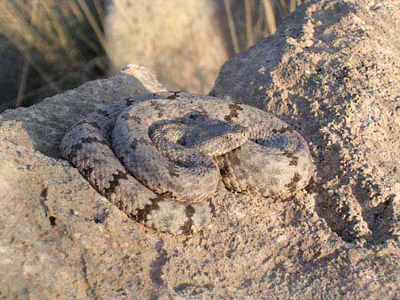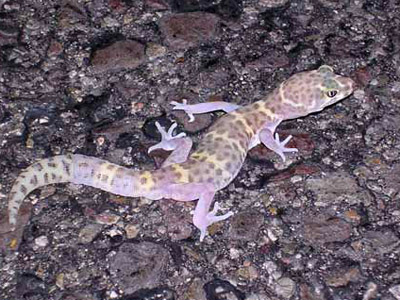Carlsbad Caverns National Park (NP) is located in southeastern New Mexico in the Chihuahuan Desert, but contains several elements of Sierra Madrean, Rocky Mountain, and Great Plains affinity, and is characterized by steep limestone canyons.

Mike Woolman
The park supports highly diverse ecosystems—including many plants and animals that are at the edges of their geographic range. Few permanent sources of water are present in the park. Rattlesnake Springs, a detached unit of Carlsbad Caverns NP, is a rare wooded riparian area. Surveys were completed in Rattlesnake Springs, the park’s sewage disposal area, and canyons and drainages throughout the park.
The inventory took place from May to August 2003 and from June to August 2004. During the 2003 survey, the park received well-below-normal levels of precipitation and it was not a good year for a reptile and amphibian surveys. The researchers did not hear any amphibians calling from within the park, and it seemed likely that some toad species remained underground all year due to the lack of monsoon rains. Snake activity is also typically correlated with rainfall. In contrast, between March and September 2004, the park received over 4.5 times as much precipitation as it did during the same period in 2003.
Methods
Several search approaches were implemented to find reptiles and amphibians: foot surveys, incidental observations, pitfall traps, and road cruising. Turtle traps were not used at Rattlesnake Springs because the pond could be adequately surveyed visually by observing basking turtles and because the steep sides of the pond were not conducive to using turtle traps. For each reptile or amphibian observed, location, time, weather, and species were recorded.
Foot surveys were conducted at times when reptiles and amphibians were most likely to be active (morning around sunrise and evening around sunset). Most of the foot surveys were conducted off-trail. While on foot, searches included looking under rocks and logs, and mirrors and flashlights were used to illuminate crevices. Incidental observations were recorded while the researchers were not conducting formal searches (e.g., on days off or while driving to a search area).
Pitfall traps were used to capture small reptiles and amphibians running or crawling across the ground. In 2003, three sets of pitfall traps were checked by park staff and volunteers daily (120 times). Road cruising surveys were conducted at night to find amphibians and nocturnal snakes and lizards.

NPS
Voucher specimens were collected for nearly every species found in the park. Voucher specimens provide proof that the species actually occurred in the park during the inventory and help to confirm it was correctly identified in the field. These specimens provide important data about reproduction, diet, health, and morphology. DNA collected from voucher specimens can be used to examine population questions and genetic relationships within and between species. For this inventory, the voucher specimens are on permanent loan to and stored at the Museum of Southwestern Biology, University of New Mexico, Albuquerque, and are freely available to researchers and managers.
Results
In total, 3,575 reptiles and amphibians were found at Carlsbad Caverns NP by the researchers and park partners during this inventory, representing 46 species: eight frogs and toads, 15 lizards, 20 snakes, and three turtles. The majority of observations were recorded during foot surveys: 2,659 animals of 38 species. Incidental observations accounted for 690 animals of 41 species and a total of 117 animals of 16 species were caught in pitfall traps. Seventy-three road cruising surveys produced 109 animals of 25 species. A total of 53 voucher specimens comprising 43 species were collected.
One species found in the park is listed as state endangered, the gray-banded kingsnake (Lampropeltis alterna), and two species found are listed as state threatened species, the mottled rock rattlesnake (Crotalus lepidus lepidus) and Rio Grande cooter (Pseudemys gorzugi).
One non-native species, the American bullfrog (Rana catesbeiana), was found during this inventory, and only at Rattlesnake Springs. This species is native to the eastern United States and was introduced to the West in the early 1900s. American bullfrogs compete with and prey on native species, particularly leopard frogs and gartersnakes.
Discussion
In order to determine what percentage of the actual total herpetofauna community was documented in this inventory, the results were compared to lists of species likely to occur in the park - specifically, the park’s 2002 reptile and amphibian checklist. It is estimated that there are probably four species that are likely to occur in Carlsbad Caverns NP that were not observed (one lizard, two snakes, and one turtle), meaning this inventory may have documented 92% of the reptile and amphibian species in the park.
This inventory can be used as baseline data for future monitoring. Long-term monitoring and/or repeated inventories may help detect changes within reptile and amphibian communities caused by climate change, drought, invasion by non-native species, wildland fire, or other factors. Reptile and amphibian populations can change dramatically between surveys in a given year due to the timing and amounts of precipitation. Future monitoring or inventories should survey each area multiple times in a season.
See Chapter 7 (Literature Cited and Project Contacts) for a link to the full report including a list of species found during this inventory.
Part of a series of articles titled Chihuahuan Desert Network Reptile and Amphibian Inventories.
Last updated: January 5, 2017
